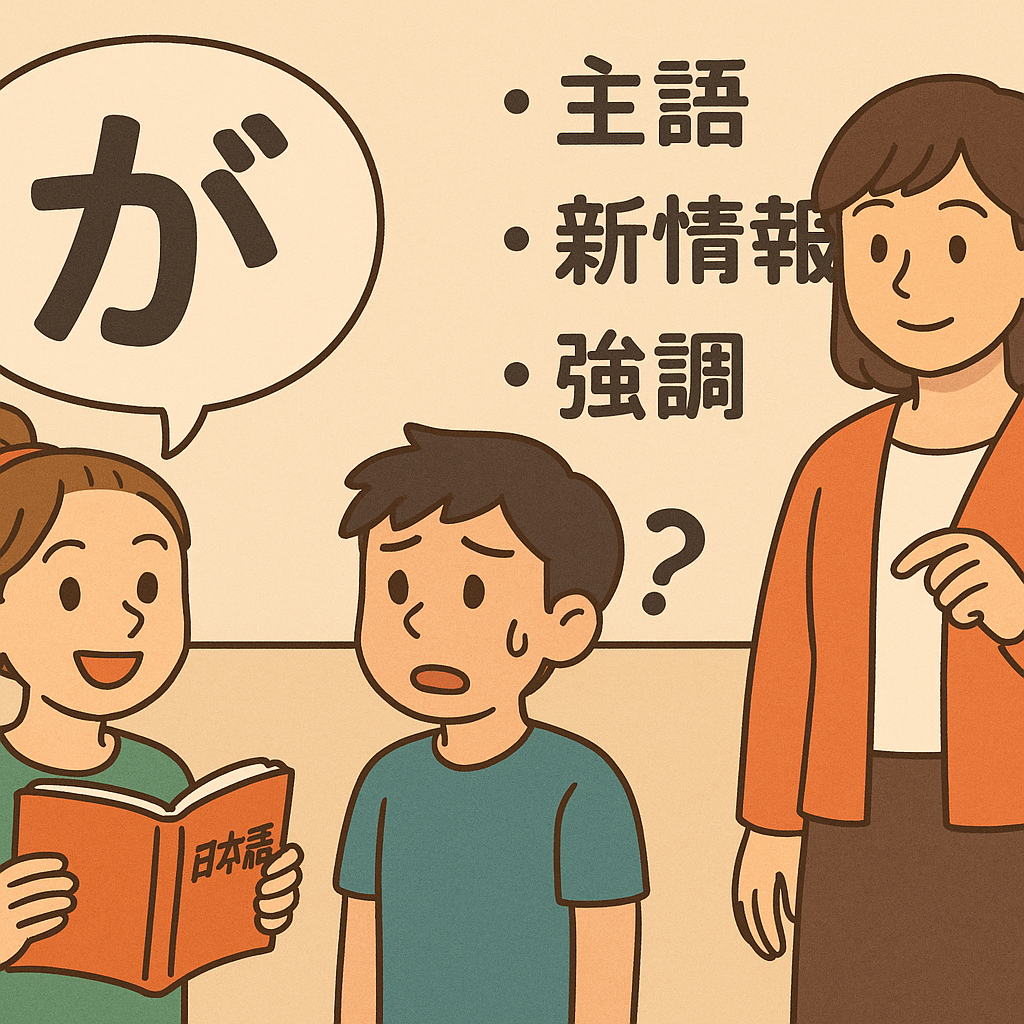
はじめに / Introduction
日本語を勉強する中で、「が」という助詞(particle)は必ず出てきます。「は」との違いが難しいと感じる人も多いですが、「が」は主語・新情報・強調など、様々な重要な役割を持っています。
この記事では、「が」の基本的な使い方から応用、会話例、よくある誤解、他の助詞との違いまで、徹底的に解説します。
When learning Japanese, you will definitely encounter the particle "が" (ga). Many learners struggle with the difference between "が" and "は," but "が" plays several important roles: subject marker, new information, and emphasis.
In this article, we’ll explain everything from the basics to advanced uses, sample conversations, common misunderstandings, and differences from other particles.
「が」の基本 / The Basics of "が"
「が」は、主語(subject)や文の中で新しい・重要な情報を表す時に使われます。
たとえば、質問に答えるときや、何かを強調したいときに使われます。
例文:
・だれが来ましたか?(Who came?)
・山田さんが来ました。(Yamada came.)
・猫がいます。(There is a cat.)
・私がやります。(I will do it.)
"が" is used to mark the subject or indicate new/important information in a sentence.
It’s often used to answer questions or to emphasize something.
Examples:
・Dare ga kimashita ka? (Who came?)
・Yamada-san ga kimashita. (Yamada came.)
・Neko ga imasu. (There is a cat.)
・Watashi ga yarimasu. (I will do it.)
主語を表す「が」 / "が" as the Subject Marker
文の主語(誰が、何が)をはっきりさせたい時、「が」を使います。
特に「だれ」「なに」など疑問文の答えになる場合や、文の中で初めて登場する情報を紹介する場合によく使われます。
例文:
・だれが来ましたか?
・田中さんが来ました。
・教室に犬がいます。
"が" is used to clearly mark the subject of a sentence ("who" or "what").
It’s especially common when answering questions like "who/what," or when introducing new information.
Examples:
・Dare ga kimashita ka? (Who came?)
・Tanaka-san ga kimashita. (Tanaka came.)
・Kyoushitsu ni inu ga imasu. (There is a dog in the classroom.)
新情報・強調の「が」 / "が" for New Information or Emphasis
「が」は、聞き手がまだ知らない新しい情報や、他と区別したいポイントを強調したいときにも使われます。
例文:
・この中で、田中さんが医者です。(Among these people, it is Tanaka who is a doctor.)
・私がやりました!(I did it! [not someone else])
・カレーが好きです。(I like curry.)
"が" can also be used to present new or previously unknown information, or to highlight or distinguish something.
Examples:
・Kono naka de, Tanaka-san ga isha desu. (Out of these people, Tanaka is the doctor.)
・Watashi ga yarimashita! (I did it! [not someone else])
・Karee ga suki desu. (I like curry.)
「は」との使い分け / Comparing "が" and "は"
「は」は話題(テーマ)を示し、「が」は主語や強調・新情報を示します。
たとえば、
・私は学生です。(As for me, I am a student.)
・私が学生です。(I am the student.)
例1:
A:だれが先生ですか?
B:山田さんが先生です。
例2:
A:山田さんは先生ですか?
B:はい、山田さんは先生です。
"は" marks the topic (theme), and "が" marks the subject or emphasizes new/important information.
For example:
・Watashi wa gakusei desu. (As for me, I am a student.)
・Watashi ga gakusei desu. (I am the student [not someone else].)
Example 1:
A: Dare ga sensei desu ka? (Who is the teacher?)
B: Yamada-san ga sensei desu. (Yamada is the teacher.)
Example 2:
A: Yamada-san wa sensei desu ka? (Is Yamada a teacher?)
B: Hai, Yamada-san wa sensei desu. (Yes, Yamada is a teacher.)
同じ文でも「は」と「が」を入れ替えることで、会話の流れや意味が微妙に変化します。
By switching "wa" and "ga," you can subtly change the focus and nuance of a sentence.
感情・自然現象・状態の「が」 / "が" for Emotions, Nature, and States
「が」は、感情や体の状態、自然現象を表すときによく使われます。
例文:
・頭が痛いです。(I have a headache.)
・雨が降っています。(It is raining.)
・心がドキドキします。(My heart is beating fast.)
"が" is also commonly used with feelings, bodily states, and natural phenomena.
Examples:
・Atama ga itai desu. (I have a headache.)
・Ame ga futteimasu. (It’s raining.)
・Kokoro ga dokidoki shimasu. (My heart is pounding.)
「が」を使った表現・会話例 / Common Phrases and Dialogues with "が"
「が」を使った典型的な会話を紹介します。
例1:
A:どのケーキが好きですか?
B:チョコレートケーキが好きです。
例2:
A:だれがきれいですか?
B:あの人がきれいです。
Here are some typical dialogues using "ga":
Example 1:
A: Dono keeki ga suki desu ka? (Which cake do you like?)
B: Chokoreeto keeki ga suki desu. (I like chocolate cake.)
Example 2:
A: Dare ga kirei desu ka? (Who is beautiful?)
B: Ano hito ga kirei desu. (That person is beautiful.)
また、「~がほしい」「~が見える」「~が聞こえる」「~が必要」など、感覚や希望・必要性を表す動詞ともよく使われます。
"Ga" is also used with verbs like "hoshii" (want), "mieru" (can see), "kikoeru" (can hear), and "hitsuyou" (need) to express feelings, senses, or needs.
よくある誤解・間違い / Common Misunderstandings and Mistakes
初学者は「が」と「は」の使い分けに苦労しがちです。
・質問に答えるときは、新しい情報を「が」で答えます。
・同じ主語が続くときは、2文目以降は「は」に置き換えるのが自然です。
例:
× 田中さんが先生です。田中さんが日本人です。
○ 田中さんが先生です。田中さんは日本人です。
Beginners often struggle with "wa" vs. "ga."
・When answering a question, use "ga" for new info.
・If you mention the same subject again, switch to "wa" for natural Japanese.
Example:
× Tanaka-san ga sensei desu. Tanaka-san ga nihonjin desu.
○ Tanaka-san ga sensei desu. Tanaka-san wa nihonjin desu.
さらに、感情や自然現象を表すときは必ず「が」を使うので、「は」を使わないよう注意しましょう。
Also, always use "ga" with feelings and natural phenomena. Don’t use "wa" in these cases!
文法応用・慣用表現 / Advanced and Idiomatic Uses
「が」は逆接の意味で「~が、…」と使うことも多いです(英語の "but" の役割)。
例文:
・行きたいですが、お金がありません。(I want to go, but I don’t have money.)
・雨が降っていますが、散歩します。(It’s raining, but I’ll go for a walk.)
"Ga" can also be used as a conjunction meaning "but."
Examples:
・Ikitai desu ga, okane ga arimasen. (I want to go, but I don’t have money.)
・Ame ga futteimasu ga, sanpo shimasu. (It’s raining, but I’ll go for a walk.)
ほかにも、「~がする(匂いがする/音がする)」や「~ができる(can)」など、たくさんの表現で使われます。
You’ll also see "ga" in many set phrases, like "nioi ga suru" (it smells), "oto ga suru" (there’s a sound), and "ga dekiru" (can / be able to).
まとめ・コツ / Summary & Tips
- 「が」は主語、新情報、強調、感情や自然現象で使う。
- 質問への答えや、初めて紹介する情報は「が」で!
- 同じ主語が続く場合は「は」に切り替える。
- 「が」は「but(逆接)」の意味にもなる。
- 会話の流れや文脈で使い分けよう。
- "Ga" is for the subject, new information, emphasis, feelings, and natural events.
- Answer questions or introduce new info with "ga."
- If you mention the same subject again, switch to "wa."
- "Ga" can also mean "but" (contrast).
- Practice using "ga" in real conversations and pay attention to context.
最初は迷って当然ですが、たくさん会話や読解の中で練習していくうちに、自然と感覚が身につきます。
あなたもぜひ、「が」の世界を楽しみながら学んでください!
Don’t worry if you’re confused at first! With lots of practice in conversation and reading, you’ll naturally get the hang of it.
Enjoy exploring the world of "ga"!